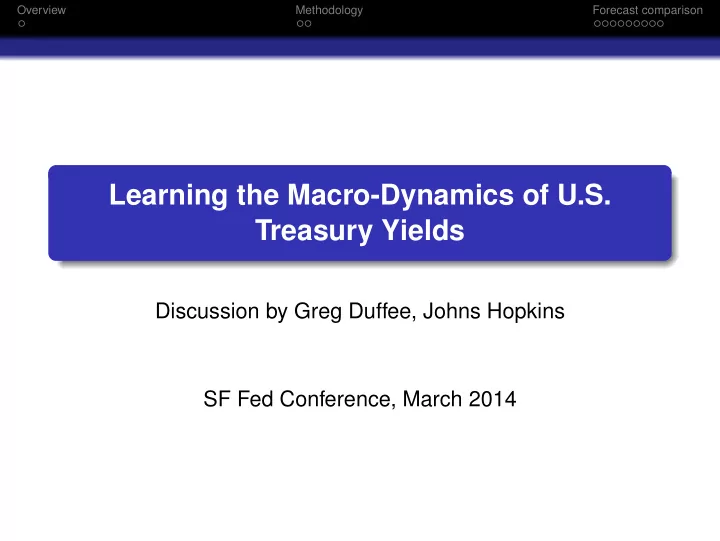

Overview Methodology Forecast comparison Learning the Macro-Dynamics of U.S. Treasury Yields Discussion by Greg Duffee, Johns Hopkins SF Fed Conference, March 2014
Overview Methodology Forecast comparison Learning (about the paper) Rigorous modeling of learning about price dynamics is hard Past and future market participants also learn; need to account for learning dynamics in setting prices Reduced-form term structure model bypasses much of this difficulty Paper argues model-based forecasts are (mostly) similar to median professional survey forecast . . . but model-based forecasts can do better if macro info is incorporated Models and professionals differ in implied dynamics of expected excess returns to long-term bonds
Overview Methodology Forecast comparison Learning (in the model) Dynamics (Simplified version) Assume reduced-form yield dynamics through t , including learning about macro dynamics, prices that depend on expectations of future learning, are approximated by a first-order, low-dimension VAR estimated at t Fit n yields to VAR through t to get params Yields on other bonds determined by restricted interpolation
Overview Methodology Forecast comparison No-arbitage restrictions Paper finds that no-arb curve-fitting function varies little over the sample Can think of learning as continually updating estimates of the VAR, don’t worry about interaction between learning and no-arb restrictions – very nice empirical result
Overview Methodology Forecast comparison Blue Chip versus model-based forecasts Paper’s conclusions Similar forecasts when model uses recursive least-squares estimation Models are more accurate when They downweight older observations They incorporate macro data in the VAR My interpretation of the same evidence Blue Chip, model-based forecasts differ substantially Model-based are more accurate because of known features of survey forecasts
Overview Methodology Forecast comparison Blue Chip, JSZ model forecasts One quarter ahead Four quarters ahead 12 12 10 10 8 8 Percent/year Percent/year 6 6 4 4 2 2 0 0 1985 1990 1995 2000 2005 2010 2015 2020 1985 1990 1995 2000 2005 2010 2015 2020 Date+Maturity Date+Maturity
Overview Methodology Forecast comparison Root mean squared forecast differences and errors Basis points, annualized yields Diff/Error Method Horizon 6 mon 5 yr 10 yr Diff BC-JSZ 1Q 23 23 24 Diff BC-JPS 1Q 37 26 26 Error BC 1Q 52 49 45 Error JSZ 1Q 40 43 38 Error JPS 1Q 36 41 39 Diff BC-JSZ 4Q 37 42 48 Diff BC-JPS 4Q 85 81 73 Error BC 4Q 148 120 106 Error JSZ 4Q 142 112 93 Error JPS 4Q 134 106 91
Overview Methodology Forecast comparison Decomposing forecast errors � � survey forecast error t = JSZ forecast error t − survey forecast t − JSZ forecast t RMSE 2 BC = RMSE 2 JSZ + RMSD 2 BC , JSZ − 2 Π( JSZ error , forecast diff ) Five-year yield, one and four quarters ahead (normalize by LHS) 1 = 0 . 755 + 0 . 210 + 0 . 035 ; 1 = 0 . 872 + 0 . 125 + 0 . 002 Replace JSZ with JPS 1 = 0 . 699 + 0 . 274 + 0 . 027 ; 1 = 0 . 725 + 0 . 335 − 0 . 060
Overview Methodology Forecast comparison Survey bias 1: Slow adjustment Coibion and Gorodnichenko: mean forecasts from surveys are sluggish (informational rigidities?) Serial correlations of monthly changes in forecasts of ten-year yield Blue Chip: 0.32 (one-Q-ahead), 0.35 (four-Q-ahead) JSZ model: 0.02 (one-Q-ahead), 0.00 (four-Q-ahead) JPS model: 0.07 (one-Q-ahead), 0.08 (four-Q-ahead)
Overview Methodology Forecast comparison Survey bias 2: Excess persistence Piazzesi/Salomao/Schneider (Trend and cycle in bond premia): survey forecasts imply much higher persistence of slope than models imply ˆ E t ( slope t + 4 quarters ) = a + b slope t + e t Point estimates of b : Blue Chip, 0.82; JSZ model, 0.71; JPS model, 0.70 Replace LHS with realized slope: b = 0 . 56
Overview Methodology Forecast comparison Forecasting the slope of the term structure 4 3.5 3 2.5 Black line: actual slope Percent/year 2 Blue line: Blue Chip 4-Q-ahead 1.5 forecast of slope 1 Red line: JSZ model 4-Q-ahead 0.5 forecast of slope 0 −0.5 −1 1985 1990 1995 2000 2005 2010 Date
Overview Methodology Forecast comparison The slope and expected excess returns Models: Steep slope implies high, transitory expected excess returns to long-maturity bonds Blue Chip: Steep slow implies moderately high, long-lived expected excess returns to long-maturity bonds
Overview Methodology Forecast comparison Conclusions Result that no-arb pricing function varies little over the long sample is surprising and useful Comparison with Blue Chip survey forecasts is too sympathetic to the survey forecasts
Recommend
More recommend